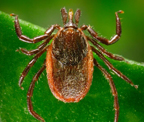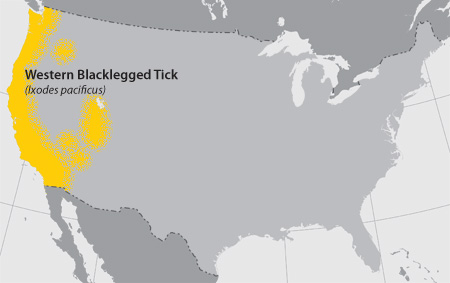Western Blacklegged Tick (Ixodes pacificus)

Western
Blacklegged Tick
The western blacklegged tick is very similar to Ixodes scapularis, the deer tick. Geographically the western black-legged tick inhabits the west coast of the US, where it is commonly found in coastal California, Oregon, and Washington.
Morphologically, it is small, red, has long, thin mouthparts, and no festoons. All species of blacklegged ticks are very small and hard to spot.
Young blacklegged ticks feed on birds, small rodents and even lizards, while the adult ticks prefer to feed on deer and other large mammals, including humans. Western blacklegged ticks and have the same typical life cycle as the deer tick (see diagram).
Blacklegged Ticks Can Transmit Lyme Disease!
Both juvenile and adult western blacklegged ticks are capable of transmitting the pathogens that cause Lyme disease and Anaplasmosis to humans.

Above: Geographical distribution of the western blacklegged tick
Identifying the Western Blacklegged Tick:
Western blacklegged ticks look virtually identical to the deer tick, but with a slightly more oval body. The most important distinguishing factor is that western blacklegged ticks are found only on the west coast of the United States.
Location: Found across the West Coast from Mexico to Canada
